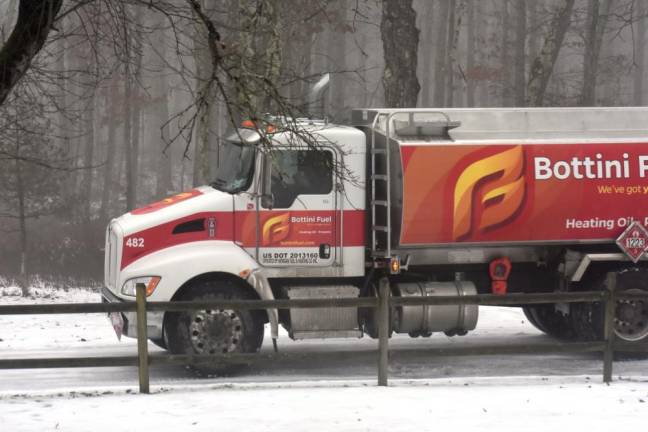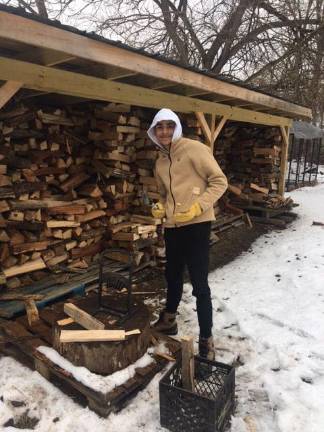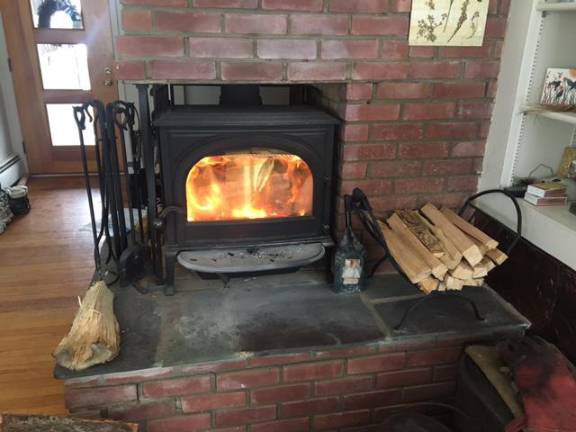Shelling out for heat
Locals are layering up, chopping wood, using space heaters and even subbing off-road diesel for heating oil.



As winter trudges on, families are struggling to keep warm without breaking the bank.
“I got my bill from O&R and it’s $429! Argh!” said Elizabeth Mangum, of Warwick, in late January. That’s three times what she pays in the summer. She had a feeling the hit was coming, since during a spell when the family was sick, she’d kept her house at 68 degrees.
“I usually put it down to 60 and use a space heater,” said Mangum, a psychotherapist who lives with her two elementary school-age kids. “We also have a fireplace, but it doesn’t seem to offer a ton of heat. Full transparency – we’ve also been using a ‘family bed’ approach and an extra duvet at night too.”
Upon calling Orange & Rockland Utilities Inc., Mangum discovered that it was actually her electric usage that had skyrocketed, not the gas as she’d assumed. The culprit, in fact, was likely the space heater she’d been using in an attempt to be frugal with gas, to warm up just a single room: the kitchen in the morning, or her home office while the kids are at school. She’d thought she would save money that way. “Sadly, I’m wrong,” said Mangum, who was planning to get a free home energy assessment offered by New York State.
The constant fluctuations in fuel prices makes budgeting for heat a byzantine business, but one thing is certain. In our cold-climate region, regardless of what fuel you use, space heating is by far the biggest energy hog, consuming well over half a household’s “juice.”
For decades, the cost of heat has been on a steady march upwards. This November through March, heating-oil customers in the Northeast can expect to pay an average of $1,701; propane users, $1,698; electricity users, $1,485; and gas users, $779, according to the U.S. Energy Information Administration’s winter fuels outlook.
The average household is expected to pay $259 more for home heating than it did at the start of the pandemic, according to the National Energy Assistance Directors Association, a federal program that helps low-income families pay utility bills.
Energy insecurity on the rise
We think of a heated home as a basic need, but the price tag increasingly puts it in the category of luxury for millions of families.
Thirteen percent of respondents to the Straus News survey said that at some point, they’ve been unable to afford to heat their homes, while a third of those surveyed said paying for heat was a household stressor.
“We notice that people, even though they were making an income, maybe a steady income, they’re still struggling with heat on top of other expenses,” said Marivette Contes, coordinator of the Orange County Fuel Fund, which provides up to $1,000 toward heat for residents who make too much to qualify for state aid. They are seeing the most referrals since the pandemic, said Contes. “People that never in their lives asked for public assistance,” she said, are finding themselves behind on bills for the first time. “They kind of panic when they receive the termination letter.”
The income cutoff for a family of four to apply for the Orange County Fuel Fund is $84,060, while the New York State’s Home Energy Assistance Program (HEAP) cuts off at $70,056. The cutoff for a family of four to qualify for HEAP in Pennsylvania is $45,000; in New Jersey, $84,830.
“We are covering that gap,” said Contes. The county fund has assisted 78 families this winter as of Feb. 1, most of them seniors and single parents of kids under 18, some dealing with medical bills, lost jobs or higher-than-usual fuel bills. “I have heard about elders that, even though they are feeling cold, but knowing they can’t pay higher bills, they put layers and layers,” said Contes.
The Orange County Fuel Trust still has the budget to help more residents, stressed Contes. “So many people think that they don’t qualify for assistance, they automatically think no no no; they could be surprised.”
Lynn Setteducato, a marketing consultant for a fuel company in the Poconos, has noticed that the phones have been quieter this year. “I would say definitely people are filling up less,” said Setteducato, of Pennywise Fuel, which services Pike County, PA. “Last two to three years the phones were ringing off the wall like you can’t believe, but it seems that this year people are cutting back as much as they can,” she said. Customers seem to be keeping the thermostat lower, she said, “and just throwing on a sweatshirt, you know what I mean? Or an extra sweatshirt.”
Tightening the belt
Respondents to a Straus News survey dealt with high heating bills in all sorts of ways: by cutting down on extras like take-out; seeking government assistance; installing heat pumps, which lowered one family’s bill by half; stretching the cost over 12-months by locking into a budget plan with their propane provider; shopping around for providers; working side jobs; foraging downed wood from underneath power lines or harvesting it from their property. In a pinch, it’s not uncommon for people who can’t or don’t want to pay for a heating oil delivery to fill up a few gas cans with diesel at the gas station instead – though some experts warn that long-term use of diesel as heating fuel can damage your furnace.
“We are using off-road diesel in lieu of oil as we do not want to fill the in-ground tank we would like to take out. We are largely using the woodstove as our primary heating for this reason,” said a Wantage, NJ couple that spends $30 a month on the off-road diesel that fuels the furnace, their secondary heat source. “We have lived here for 31 years and have needed to replace our furnace for 25 of them.”
(Diesel is essentially the same substance as heating oil, though with additional lubricants. Off-road diesel, dyed red to differentiate it, is cheaper than on-road diesel because it’s not subject to the same taxes.)
In December, when a mom posted on an Orange County moms Facebook page that she was out of heating oil, her house was 50 degrees and she was already behind on rent, at least 15 other moms suggested getting a few gallons of diesel to tide her over – and quickly, to avoid frozen pipes. Five others offered to donate a space heater.
Getting creative
When it comes to keeping warm, there’s no end to the ingenuity of cold-climate natives: cuddling up under an electric blanket, strategically using a space heater to warm the bathroom while the shower’s in use, redesigning and hyper-insulating an older “energy sieve” house to maximize solar gain.
“I put on a 30-pound winter coat every year and sweat it off in the spring,” said Raphael Cox, of Warwick, who works on a farm.
“We bake a lot more and leave the oven on to help warm the house and offset the cost of oil,” said Amanda Predmore of Smartswood (Newton), NJ. Six people spanning four generations live under the same roof – “some are always hot and others are always cold,” said Predmore. “We can’t even afford to pay for medication, so we definitely can’t afford to remodel the house to install a different type of heat.”
Economical fire hazards
Portable space heaters are increasingly popular: affordable up front, when used judiciously, they can help trim a home’s heating bill, particularly for larger houses. They are also far and away the most dangerous piece of home heating equipment.
“People are having issues with income, so they’re using alternate sources of heat, which is not really that good for the fire service,” said John Cosh, chief of Pochuck Valley Fire Department in Sussex County, NJ. At a Vernon Township Council in July, Cosh pointed to alternate heat sources as a likely cause – along with type of building construction, fire alarms that automatically call the fire department and complaints about neighbors’ outdoor fires – of the surge in calls to his shrinking department: from 159 calls in 2000 to 427 in 2022.
Fires caused by home heating equipment, which peak between December and February, account for a sixth of all home fires and almost one-fifth of home fire fatalities, according to the National Fire Protection Association.
Home heating fires have been trending down for two decades, likely thanks to improved safety standards like automatic cutoff devices for tipped-over space heaters, more guarding around heating coils of electric heaters and burners of kerosene heaters. But space heaters remain 15 times more deadly than a chimney or fireplace, responsible for one-third of all home heating fires and a disproportionate nine in ten fatalities in home-heating equipment fires, according to the NFPA’s 2022 Home Heating Fires report.
The multi-pronged approach: ‘the house is just too cold without it’
In the Northeast, where homes tend to be older, many employ a multi-pronged approach to keeping warm. The majority of our 445 survey respondents use a secondary heat source (although we did not count the responses “sweatshirt” and “blanket” as secondary heat sources.)
Marlene Coscia and her husband, of Vernon, NJ installed a propane fireplace about eight years ago to supplement the electric baseboard heat in their 2,800 square-foot house, removing the wood-burning stove fireplace insert that was there when they moved in nearly three decades earlier. The couple’s four kids are grown, so they keep the thermostats to the unused bedrooms off and those doors closed.
“I still miss the look and the smell and the crackle of a real fire,” said Coscia, who works in early intervention, but “this kind of fit the bill. It does warm up the living room and then the rest of the house. We gave up the smell and stuff, but we also gave up the work of having a wood stove.” Like a wood stove, she said, the propane fireplace will still work in the event of a power outage.
When she goes outside and smells smoke from her neighbors’ wood fires, “I’m very envious, but the convenience of literally clicking the remote and pow, the heat starts, that supercedes everything,” she said. “Plus I’m not vacuuming all the time. I’m a little OCD.”
Lynn Setteducato, of Tobyhanna, PA, the fuel company marketing consultant, has electric baseboard heat in her 1,800-square-foot house, which for a year she has been supplementing with an electric space heater to warm the living room. “I turn it on as soon as I get home; it heats up the whole room. The house is just too cold without it, you know? Especially the downstairs,” she said.
Setteducato, who lives with her 26-year-old daughter, has trouble paying her “huge” $800 electric bill in January and February. (The average heating bill among our survey respondents was $300 a month. Across the state line, the Coscias, whose much bigger house is also heated primarily by electric baseboard heat and who also like to keep it at 72, pay half what Setteducato does. Such are the vagaries of heating.)
Setteducato gives up eating out in the winter. Still, she will probably either have to borrow money from someone or withdraw it from her mutual fund to cover the heating bill, which she’s done before.
“It’s just the fact that it’s electric heat makes my bill outrageous,” she said. Though electric heat pumps are among the most environmentally friendly options out there (with federal tax credits to defray the cost of installation) older electric heating systems can be relatively inefficient. “I’ve been thinking about switching to propane,” said Setteducato, “which would be somewhere in the middle.”
Hacking it: the wood-burning lifestyle
Those who can hack it (sorry) save big bucks by burning wood. Across the Northeast, wood is the main heat source for 470,000 households, according to the EIA – a little over two percent of homes. In our neck of the woods, the wood-burning lifestyle appears to be a lot more popular: nearly 10 percent of survey respondents’ primary heat source is a wood or pellet stove.
“We’re definitely saving a lot,” said Tara Lambert, of Warwick, who installed a Jotul wood-burning stove in her 2,000-square-foot house around 2017. Lambert, a licensed clinical social worker and mother of a pair of high-school-age twins, gets her wood free from a friend who works for a tree service. Even when purchased, wood is among the most inexpensive heat sources.
“I don’t get up in the middle of the night to load my wood stove, so for really cold temperatures like we just had, the furnace kicks on in the middle of the night,” said Lambert. Her natural gas fired furnace kicks on when the thermostat drops below 60 degrees. Even so, the wood-burning stove has at least halved her utility bill, she estimates, paying for itself many times over.
Each spring, she and her friend use a splitter to chop the rounds into logs, a job that takes a few days. “It really is a lot of work,” she said. “For me, after four hours max, I’m like alright, I can’t do this anymore.”
Then comes stacking the wood in the woodshed, splitting the logs into kindling (her son’s job), and hauling the wood to the house as needed. “I don’t at this point in my life find it to be hard to do, it’s just – it is physical work,” she said. “Not everyone can do it.” A survey respondent from Vernon who lives alone, for instance, said that she couldn’t use her pellet stove as a secondary heat source because the bags of pellets were too heavy.
Like its fossil fuel counterparts, burning wood has its environmental downsides. New York and New Jersey are among 10 states whose attorneys general have threatened to sue if the Environmental Protection Agency doesn’t update its wood-burning appliance emissions standards, the lack of which is putting people at risk of exposure to particle pollution, say the states.
A second Warwick home that Lambert co-owns is heated exclusively with wood. The 800- square-foot house has two wood burning stoves, one upstairs and one in the basement. In that house, the furnace hasn’t been on in decades.
The savings are nice, but so is the knowledge that a power outage won’t leave you exposed to dangerous temperatures. Lambert grew up part-time with her maternal grandmother, a Native American who lived in and around the Hudson Valley up through the Canadian border, and was never without a wood-burning stove or fireplace. “My grandmother, her approach to it was: in the wintertime if you lose electricity, how are you going to keep your house warm? I never heard her speak about the money – I’m sure the money was part of it – she just spoke about it in terms very practical: if you don’t have electric, you won’t be able to stay warm. That was just nuts to her. You had to have the ability to stay warm, keep your pipes from freezing and all that so you didn’t have to worry about it.”
It’s a mindset that Lambert has come to share wholeheartedly. “When we have bad storms in the winter, I always tell my kids, well if the electric goes out we’ve got our flashlights, but we’ll be warm no matter what,” she said. “We don’t have to worry about being warm. It gives me peace of mind, for sure.”
Survey respondents said:
The people who aren’t paying for the heat (my children) complain that it is too cold. This year I obliged them by setting the thermostat at 68 instead of the usual 65. At night it’s 60. – Milford, PA
I would convert to natural gas if it were an option in my area – Andover, NJ
I have a pellet stove but do not use it because the pellets are too heavy. – Vernon, NJ
This is our first winter with a wood stove with oil as our backup. – West Milford, NJ
Another big bill after Christmas, about 1,500 to fill oil tanks. – Andover, NJ
Would switch to natural gas if it were to become available. Oil is way too expensive. And maintenance is costly. – Newton, NJ
Husband likes heat off at nite, Wife wants heat at nite. – West Milford, NJ
While we’re renting we don’t have much choice. – Warwick, NY
If I use the wood stove, keeps electric heat costs down. – Blooming Grove, NY
Too expensive to change. Did check out solar but that was prohibitive. – Hawley, PA
Our house has a draft through it and no heat on the top level... the state helped us with oil. – Vernon, NJ
We worry about cost, do everything possible to keep costs down. – Hawley, PA
One member of my household is disabled, and being too cold (or too hot) would be destabilizing, so we can’t quibble over the cost. – Warwick NY
